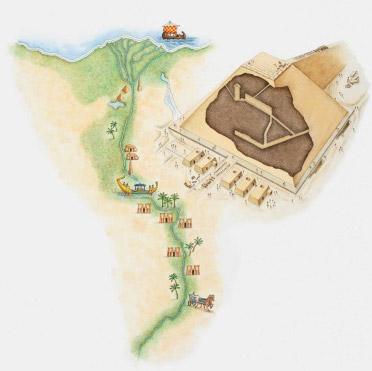
The northern section of the river flows through the desert, from Sudan to Egypt. The civilization of Egypt has been depending on the river ever since its birth. The population grew up along the banks of the river Nile. Large number of historical and cultural sites had been found on the riverbanks as well.
River Nile flows through ten countries, such as, Sudan, South Sudan, Uganda, Burundi, Rwanda, Democratic Republic of the Congo, Tanzania, Kenya, Ethiopia and Egypt, before ending up in a large delta. Finally the river flows into the Mediterranean Sea.
 The Nile is still a significant river of Egypt. Egypt and its civilization are the gifts of the Nile. Egyptian civilization grew up 3000 years before the roman civilization. It was dependent solely on the rich Ethiopian mud of the river Nile. Every summer, Nile became furious and flooded its adjacent valleys. The silt, collected on the inundated Nile banks, made the surrounding lands very fertile. The ancient Egyptians cultivated and traded wheat, flax and papyrus on the banks of the river Nile.
The Nile is still a significant river of Egypt. Egypt and its civilization are the gifts of the Nile. Egyptian civilization grew up 3000 years before the roman civilization. It was dependent solely on the rich Ethiopian mud of the river Nile. Every summer, Nile became furious and flooded its adjacent valleys. The silt, collected on the inundated Nile banks, made the surrounding lands very fertile. The ancient Egyptians cultivated and traded wheat, flax and papyrus on the banks of the river Nile.
The trades between various countries along the river Nile made Egypt an economically secured nation. It is due to this trading system, water buffaloes and camels were brought all the way to Egypt during 17th century from Asia and Persia. These animals were mostly domesticated or killed for tasty meat. Camels were used for ploughing and carrying waters from the river Nile. This process was very important both for the people and their livestock.
Nile also played a pivotal role in the spiritual world of Egyptian civilization. It was thought to be the gateway from life to death and afterlife. The east coast was believed to be the place of birth and the west coast was considered to be the place of death. This belief had actually originated from the journey of sun, which rises in the east and sets in the west. The Egyptians used to refer the sun as their god Ra. That is why all the tombs and pyramids are seen on the west bank of the river Nile.
The historical Nile is the sustenance of Egypt. Both economical and political aspects of Egypt are largely dependent on the river Nile. The prominent Rive Nile truly is the root of the Egyptian civilization.
Try out the other sections